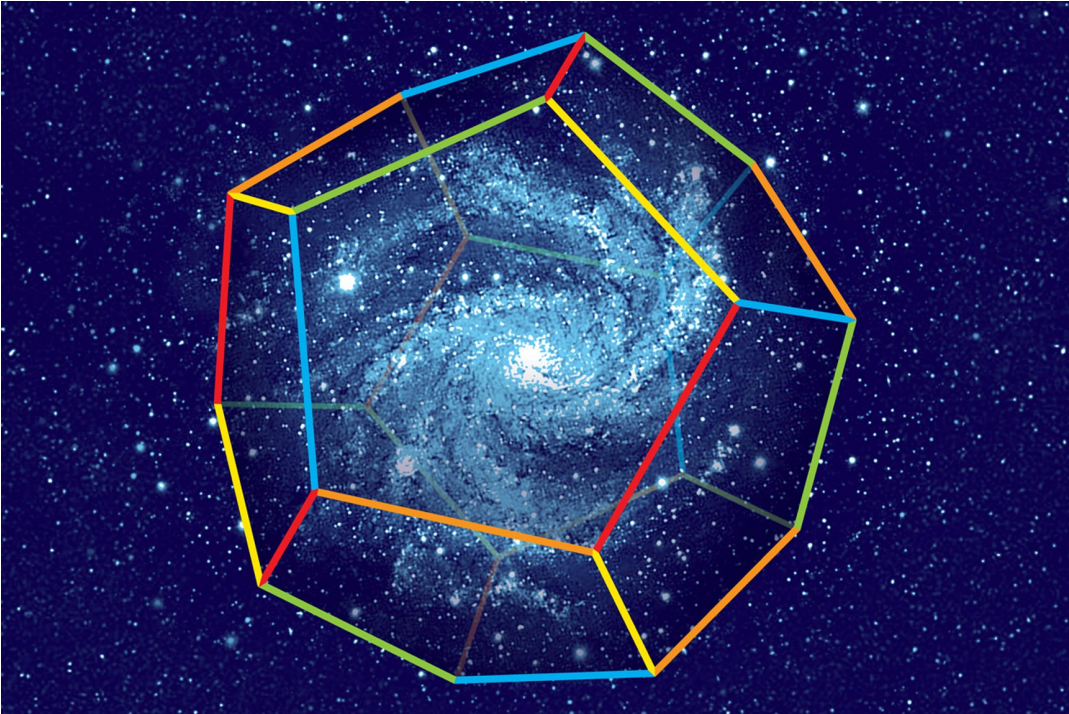撰文 | Frank Wilczek
翻译 | 胡风、梁丁当
中文版

历经两千多年历史,经历了相对论和量子力学革命,古希腊的几何学至今仍在发挥影响。公元前约300年,古希腊数学家欧几里德写下了他著名的《几何原本》 (Elements) 。这本书是思想和表达方式的不朽之杰作。它以几条明确设定的、不言自明的公设或公理为前提,通过演绎与推理,得到了丰富的、强有力的、甚至惊人的结论。《几何原本》不仅是空间几何与测量科学的好教材,也广泛用于培养与提高学生的逻辑思维能力。两千多年来,尽管期间有发展非常缓慢的阶段,科学已经有了非常大的进展,而欧几里德几何,尽管有些缓慢的拓展与变化,却延续至今。
牛顿的经典力学与万有引力以及麦克斯韦的电磁场理论,均建立在欧几里德几何的基础上。这些理论引入了粒子、场和力的概念,但它们存在的空间却是由欧几里德几何描述的空间。在欧几里得几何的所有公设中,平行公设似乎不那么令人信服。平行公设说 :通过一条直线上不同点的两条垂线永远不会相交,但通过这两点的所有其他线都会相交一次。
19世纪的数学家发现,如果对平行公设进行修改,而保持其他几个公设不变,就能漂亮地推理出关于曲面几何的正确描述。德国数学家黎曼则用了更激进的方法。为了描述曲面和高维的超曲面,他提出在小尺度上欧几里德几何总是适用的,因为此时曲率的影响可以忽略不计。而如果要描述大尺度上的空间,必须将局部的几何描述编织在一起。比如,一名高山滑雪运动员在跌宕起伏的山上比赛时会尽力保持直滑下降,但她在整个过程中的滑雪轨迹却是一条曲线。
1905年,爱因斯坦提出了狭义相对论。他的老师闵科夫斯基受到启发,对欧氏几何作了另一种推广。1908年,闵科夫斯基在演讲《空间与时间》 (Space and Time) 的结尾宣称:“从现在起,孤立的空间与孤立的时间注定将黯然消失,只有两者的某种统一才能保持独立的存在。”但是闵可夫斯基时空仍然植根于欧氏几何。虽然它对平行公设进行了简单的推广,但在固定的时间,其时空的“空间”部分是纯粹的欧几里得空间。
直到1915年,类似黎曼对欧几里得空间的修改,爱因斯坦将曲率引入闵可夫斯基时空,建立了广义相对论。基于弯曲时空的广义相对论非常成功。它为众多远超古希腊人想象的科学预言提供了理论基础,如宇宙膨胀、引力波、以及连接遥远时空的虫洞。然而,爱因斯坦的理论框架依然带着鲜明的欧几里德几何的印记——通过对欧几里得空间进行拓展与修改,纳入了时间和大尺度的曲率。
量子效应似乎破坏了欧几里得空间的核心基础,即空间能够被精细切分并被度规测量的可能性。一把真正的标尺是由原子组成的,而原子是由弥散在空间的电子波函数构成的。后来的数学发展还发现,除了平行公设,其它的欧几里德公设也都并非不证自明。比如,他的连续体很难严格定义 ;如果你能一个一个地数物理空间的点,就像我们在(简化的)数字图像中所做的那样,那就容易多了。
然而,在用来描述基本相互作用的标准模型中,我们依然看见了欧氏几何的身影 :相对论量子场仍然存在于欧几里德的连续空间中,更准确地说,是存在于爱因斯坦的狭义相对论时空中。我想,这大概就是著名理论物理学家尤金 · 维格纳 (Eugene Wigner) 所说的“数学在自然科学中不合理的有效性”吧。
英文版
The geometry of ancient Greece has stood for more than two millennia, even after relativity and quantum mechanics.
Euclid wrote his famous textbook of geometry, the “Elements,” around 300 B.C. It is a masterpiece of thought and exposition. The “Elements” deduces abundant, surprising, and powerful consequences from a few clearly stated, “self-evident” assumptions, or axioms. It served to train many generations of students not only in the science of space and measurement but in the art of clear thinking and logical deduction. A lot has happened in science since the book appeared more than two millennia ago—though there were some very slow stretches—but somehow Euclid endures.
Isaac Newton’s system of classical mechanics and gravity and James Clerk Maxwell’s system of electromagnetism were built upon the foundation of Euclidean geometry. They added particles, fields, and forces, but the space in which those things lived was Euclid’s.
One of Euclid’s axioms, the so-called parallel postulate, seemed to many later readers less compelling than the others. It says that perpendiculars drawn from two different points on a line never meet but that all other pairs of lines through those points intersect once. In the 19th century, mathematicians showed that by slightly modifying Euclid’s parallel postulate while keeping his other axioms, you can get a lovely—and correct—description of how geometry works on the surface of a sphere.
The German mathematician Bernhard Riemann took a more radical approach. Inspired by the prospect of describing surfaces and higher-dimensional hypersurfaces, he proposed that Euclid’s geometry becomes accurate at short distances (where the effect of curvature is negligible) but that to describe large-scale geometry one must weave together the local descriptions. Thus, for example, an Alpine skier racing down a bumpy mountain will keep doing her best to go straight down, but over the course she will trace a curve.
Albert Einstein’s 1905 special theory of relativity inspired one of his teachers, Hermann Minkowski, to propose another generalization of Euclidean geometry. At the end of his 1908 lecture “Space and Time,” he proclaimed, “Henceforth space by itself, and time by itself, are doomed to fade away into mere shadows, and only a kind of union of the two will preserve an independent reality.” Yet Minkowski’s space-time is still rooted in Euclid. It incorporates a simple generalization of the parallel postulate, and its “space” part, at any fixed time, is pure Euclid. It was left to Einstein, in his 1915 general theory of relativity, to do for Minkowski what Riemann had done for Euclid, that is, to bring in space-time curvature.
This framework has worked brilliantly. It supports applications that Euclid never dreamed of, such as the concepts of expanding universes, gravitational waves and (speculatively) wormholes that connect otherwise far-off places. Yet Einstein’s framework is still recognizably Euclidean, extended and adapted to bring in time and large-scale curvature.
Quantum phenomena, it might seem, undermine the most basic underpinnings of Euclid’s concept of space: the possibility to divide it finely and measure it with rulers and compasses. Real rulers are made of atoms, and atoms are cloudy assemblages of wavy electrons. Later developments in mathematics also rendered some Euclidean assumptions seem the opposite of “self-evident.” His continuum is quite challenging to define rigorously; it would be much easier if you could count the points of physical space, as in effect we do in our (simplified) digital images of it.
And yet our Standard Model of fundamental interactions still has Euclid under the hood. Its relativistic quantum fields still live in Euclid’s continuum—or more precisely, in Einstein’s update. To me, this is the most striking example of what Eugene Wigner called “The Unreasonable Effectiveness of Mathematics in the Natural Sciences”.
Frank Wilczek

弗兰克·维尔切克是麻省理工学院物理学教授、量子色动力学的奠基人之一。因发现了量子色动力学的渐近自由现象,他在2004年获得了诺贝尔物理学奖。
本文经授权转载自微信公众号“蔻享学术”。
0
推荐




 京公网安备 11010502034662号
京公网安备 11010502034662号 